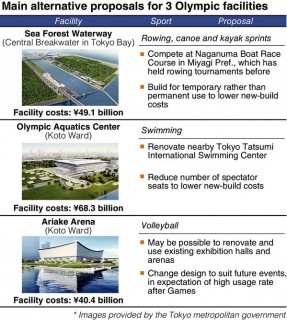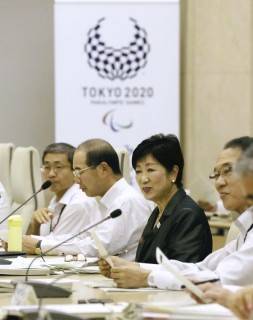Loading
Search
▼ Panel Warns Tokyo Olympics Price Tag Could Top ¥3 Trillion
- Category:Other
TOKYO (Jiji Press) — The total costs for the 2020 Olympic and Paralympic Games in Tokyo would surpass ¥3 trillion if the present plans were to be implemented, a panel commissioned by the metropolitan government said Thursday.
To cut the costs, the panel proposed a drastic review of three of the seven permanent competition facilities for the games that will be built for continued use after the event concludes. The three facilities are for rowing and canoeing, swimming and volleyball.
Tokyo Gov. Yuriko Koike, speaking at a meeting where the panel presented the estimate and proposals, said the metropolitan government will find the “best solution” to make the Games a success.
The total costs were initially projected at ¥734 billion. But the latest estimate shows that ¥764 billion will be required only for building competition venues, including the new National Stadium, and related infrastructure.
Of the total, ¥280 billion will be spent to build temporary facilities that will be removed after the games, way over the initial estimate of some ¥80 billion.
In addition, security and transportation costs are newly estimated at between ¥1.2 trillion and ¥1.6 trillion. Poor budget management by the metropolitan government, including placing expensive construction orders, is a reason for the rising costs, the panel said.
To cut the costs, the panel proposed a drastic review of three of the seven permanent competition facilities for the games that will be built for continued use after the event concludes. The three facilities are for rowing and canoeing, swimming and volleyball.
Tokyo Gov. Yuriko Koike, speaking at a meeting where the panel presented the estimate and proposals, said the metropolitan government will find the “best solution” to make the Games a success.
The total costs were initially projected at ¥734 billion. But the latest estimate shows that ¥764 billion will be required only for building competition venues, including the new National Stadium, and related infrastructure.
Of the total, ¥280 billion will be spent to build temporary facilities that will be removed after the games, way over the initial estimate of some ¥80 billion.
In addition, security and transportation costs are newly estimated at between ¥1.2 trillion and ¥1.6 trillion. Poor budget management by the metropolitan government, including placing expensive construction orders, is a reason for the rising costs, the panel said.
As for the rowing and canoeing facility that is planned to be built in the Tokyo Bay area at a cost of ¥49.1 billion, the panel proposed switching the venue to an existing facility in Tome in the northeastern prefecture of Miyagi or elsewhere.
Holding an event in the country’s northeast severely damaged by the 2011 earthquake and tsunami will meet the goal of letting the games showcase the reconstruction from the disaster, the panel said.
Regarding the swimming pool, also to be built in the Tokyo Bay area at a cost of ¥68.3 billion, the panel proposed scaling down the size of the facility or renovating an existing pool located nearby.
For volleyball, the panel called for reducing the size of the planned ¥40.4 billion arena or using a nearby exhibition hall.
The panel noted that under the current plans, the cost efficiency of these three facilities is uncertain because the number of users after 2020 was likely overestimated.
To review the construction plans, however, negotiations with the International Olympic Committee and other bodies will be needed.
The panel also said the metropolitan government should shoulder the costs for building five temporary competition facilities in Tokyo, including a cycling course. As for temporary facilities to be built outside the capital, the panel proposed local governments pay the costs with financial support from the state.
Under the current plans, the Tokyo Olympic organizing committee is scheduled to shoulder all costs for temporary facilities.
Holding an event in the country’s northeast severely damaged by the 2011 earthquake and tsunami will meet the goal of letting the games showcase the reconstruction from the disaster, the panel said.
Regarding the swimming pool, also to be built in the Tokyo Bay area at a cost of ¥68.3 billion, the panel proposed scaling down the size of the facility or renovating an existing pool located nearby.
For volleyball, the panel called for reducing the size of the planned ¥40.4 billion arena or using a nearby exhibition hall.
The panel noted that under the current plans, the cost efficiency of these three facilities is uncertain because the number of users after 2020 was likely overestimated.
To review the construction plans, however, negotiations with the International Olympic Committee and other bodies will be needed.
The panel also said the metropolitan government should shoulder the costs for building five temporary competition facilities in Tokyo, including a cycling course. As for temporary facilities to be built outside the capital, the panel proposed local governments pay the costs with financial support from the state.
Under the current plans, the Tokyo Olympic organizing committee is scheduled to shoulder all costs for temporary facilities.
- October 1, 2016
- Comment (0)
- Trackback(0)



